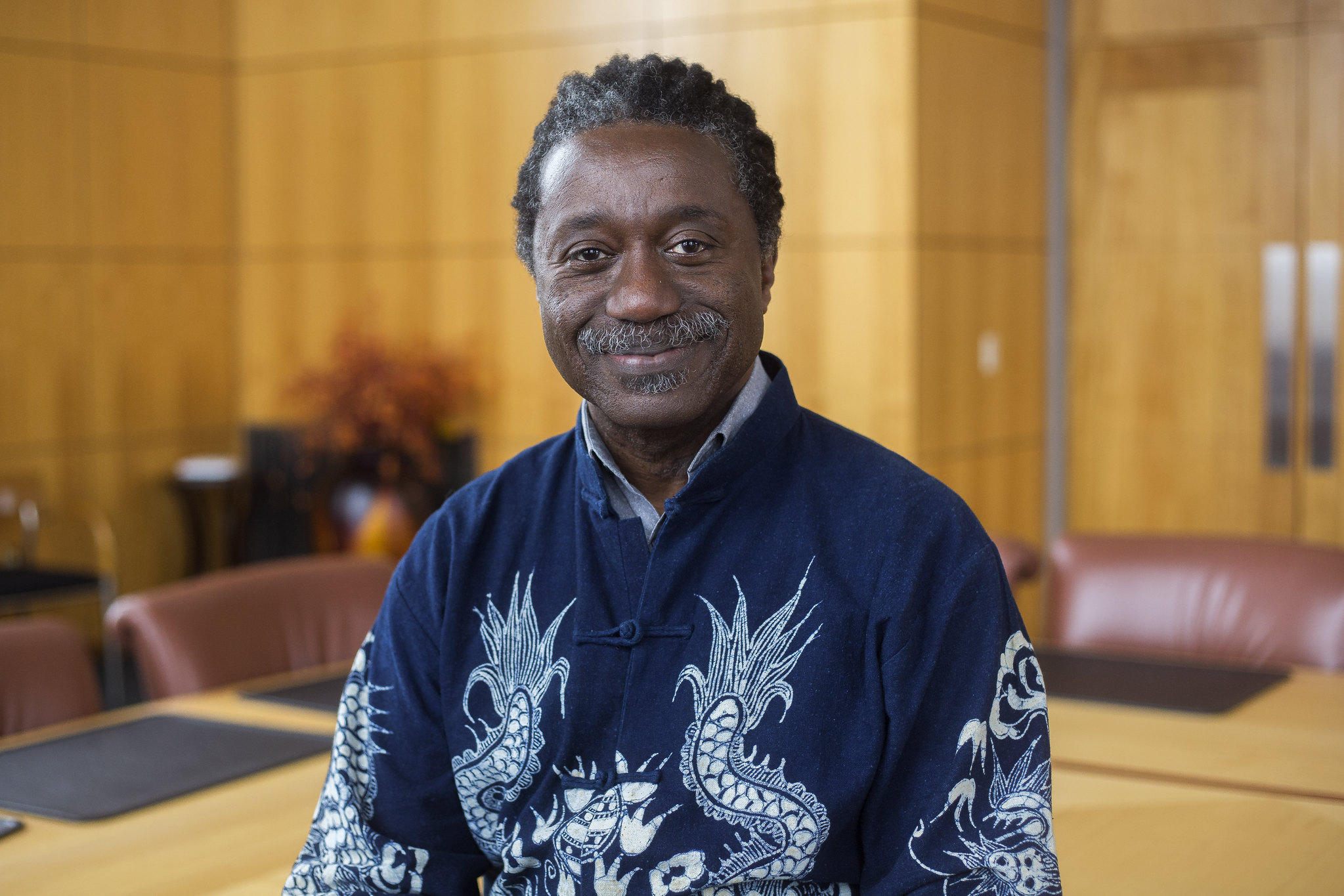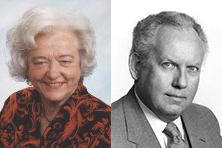Herbert Winful named Joseph E. and Anne P. Rowe Professor of Electrical Engineering
Winful has made fundamental contributions to nonlinear optics and the physics of tunneling, while also championing an inclusive department.

 Enlarge
Enlarge
Herbert Winful, Arthur F. Thurnau Professor, has been named the Joseph E. and Anne P. Rowe Professor of Electrical Engineering for his distinguished record of research, teaching, and service.
Winful has made fundamental contributions in many areas, including nonlinear fiber optics, nonlinear optics in periodic structures, the nonlinear dynamics of laser arrays, the propagation of single-cycle pulses, and the physics of quantum tunneling
He was the first to include an intensity-dependent refractive index in periodic dielectric structures, also known as photonic crystals, thus launching a field that has produced phenomena such as optical bistability, gap solitons, pulse compression, and self-pulsations. In 2000 he proposed the distributed-feedback fiber Raman laser based on fiber Bragg gratings as a source of very narrow linewidth infrared radiation. Several years later his idea was turned into reality at OFS Labs (formerly Bell Labs) and at the Optoelectronics Research Center in Southampton.
In the area of semiconductor lasers, he was the first to show that an array of coherently coupled semiconductor lasers can develop an instability in which the lasers pulsate in an apparently random but yet deterministic manner referred to as chaos. Remarkably, certain subsets of the coupled lasers would also exhibit perfectly synchronized but chaotic oscillations, a phenomenon known as synchronized chaos.
In addition to predicting new phenomena and proposing novel devices, Winful has a passion for resolving old scientific mysteries. Quantum tunneling is when atoms pass through potential barriers. One of the most perplexing mysteries of tunneling was how particles seemed to travel faster than the speed of light when passing through a barrier, but not when they travel through empty space. Additionally, the time spent by the particle in the barrier does not seem to increase as the barrier is made longer and longer, a phenomenon known as the Hartman effect.
This paradox has stirred debate in the physics community since 1932, but in 2006, Winful showed that what’s being calculated and measured isn’t the time it takes the particle to go from A to B (passing through a barrier in between), but rather the time it takes to empty the barrier of energy already stored in the barrier. The technical term for this time is the “group delay.”
“This is an important question from a fundamental physics viewpoint, but it’s also important because it can tell you the ultimate speed tunneling devices can operate,” said Winful. “My result is actually a bit of a downer, because it shows that we can’t [travel faster than light].” But, he said, it’s comforting to know that Einstein was right. Einstein’s theory of relativity tells us that nothing can travel faster than light, about 186,171 miles per second.
Quantum tunneling is used in scanning tunneling microscopes, which make observations at the atomic scale possible, and certain electronic devices, such as tunneling diodes and Josephson junctions.
Another mysterious effect that Winful has explained is the Gouy phase shift, in which a focused beam of light undergoes a 180 degree phase shift in passing through a focus. This phase shift plays an important role in determining the resonance frequencies of the transverse modes of a laser and is also responsible for reshaping single-cycle pulses propagating in free space.
The physical origin of this phase shift has been a mystery ever since L. G. Gouy discovered it in 1890. In a stroke of insight, Winful and his student Simin Feng showed the Gouy shift arises from the transverse confinement of the beam, which, through the uncertainty principle leads to a spread in transverse momenta and an elongation of the longitudinal momentum vector, akin to the effect of squeezing a tube of toothpaste. With this understanding, Winful also proposed an elegant way to observe this phenomenon with single-cycle terahertz pulses and took part in the first non-interferometric measurement of the Gouy shift with collaborators in the Center for Ultrafast Optical Science (CUOS).
In addition to his research contributions, Winful is known as a leader for efforts that champion a more inclusive and diverse engineering community. He received the Raymond J. and Monica E. Schultz Outreach and Diversity Award from the College of Engineering for his efforts in organizing diversity, equity, and inclusion programs, offering mentorship, and championing improvements in local and global communities. In 2019, he became the PI for the Michigan Louis Stokes Alliance for Minority Participation (MI-LSAMP), a multi-year, multimillion-dollar program involving 5 partner universities and community colleges aimed at increasing the number of underrepresented minorities who graduate in STEM fields.
Winful served 11 years as the Director for Education and Outreach for CUOS. In this role, he collaborated with organizations such as the African-American Academy and the Detroit Area Pre-College Engineering Program (DAPCEP). He also ran National Science Foundation Research Experiences for Undergraduates (REU) and Research Experiences for Teachers (RET) sites, bringing many underrepresented minority participants to U-M.
In addition, he serves as the faculty advisor to the Society of Minority Engineers and Scientists – Graduate Component (SMES-G), a role he’s held now for 20 years. He helps the group recruit and retain STEM graduate students of color. In 2017, the group honored Winful with the Outstanding Mentorship Award for his “relentless dedication” as their advisor and mentor. More recently Winful provided guidance as the group deliberated and then went through a name change to become the Graduate Society for Black Engineers and Scientists.
Within the EECS Department, Winful founded the Committee for an Inclusive Department and serves as the department’s DEI Lead. He created the Willie Hobbs Moore Distinguished Alumni Lectureship that brings minority ECE PhD alumni to campus to speak about their work and to interact with and mentor current students. Each year, he helps the faculty in their inclusive teaching by creating and sharing with the department Powerpoint slides highlighting the achievements of notable African-American and LGBTQ scientists and engineers.
Winful also acted as the lead for U-M’s role in USAID’s Excellence in Higher Education for Liberian Development (EHELD) program, which aimed to rebuild Liberia’s engineering and agriculture programs after a prolonged civil war. He developed new engineering curricula, recruited Liberian students for graduate studies, and managed many groups, from undergraduate groups traveling during the summer to graduate students and faculty teaching abroad.
Kelly Askew, collaborator on the project and professor of Anthropology and Afroamerican and African studies, wrote, “Prof. Winful has advanced to an immeasurable degree our STEM collaborations in Africa.” Additionally, because of EHELD and U-M’s participation, the University of Liberia was recently able to start a new College of Engineering separate from its College of Science and Technology.
In the classroom, Winful has established a reputation as one of the finest teachers in the department. In addition to teaching a wide range of EE courses, from undergraduate circuits to graduate nonlinear optics, he was instrumental in developing and team-teaching the interdisciplinary course UARTS250 (Creative Process), which is taken by students from all over campus and has been called one of the university’s most intriguing courses.
Prof. Winful is a Fellow of the Optical Society of America, the American Physical Society, and Life Fellow of IEEE. His other honors and awards include the Arthur F. Thurnau Professorship, the Provost’s Teaching Innovation Prize, the Amoco/University Teaching Award, the State of Michigan Teaching Award, the College of Engineering Teaching Excellence and Service Excellence Awards, two EECS Professor of the Year Awards, and an NSF Presidential Young Investigator Award.
About Joseph E. and Anne P. Rowe

 Enlarge
Enlarge
Joseph (BSE, EE and Engineering Math, 1951; MSE PhD, EE, 1952 1955) and Anne Prine (BSE MSE Chemistry 1950 1968; PhD Engineering Materials – now Materials Science and Engineering – 1973) Rowe met as undergraduate students at the University of Michigan. They married in 1950, and went on to forge remarkable careers in their respective fields of electrical engineering and materials science.
Joseph was one of the major pioneers in the area of microwave devices and, in particular, vacuum tube devices such as traveling wave tubes and magnetrons. Such components are still in wide use today in many applications, including high-power communication and radar systems as well as microwave ovens. His 1965 book, Nonlinear Electron Wave Interaction Phenomena, is a standard in the field.
Joseph Rowe joined the University of Michigan faculty in 1953. He served as director of the Electron Physics Laboratory from 1958 to 1968, where he managed and developed research programs in microwave electron tube devices, gaseous plasmas, and semiconductors. He was appointed Chair of Electrical and Computer Engineering in 1968 and served in that position until he left the university in 1974. Under his leadership, the Electron Physics Laboratory became one of the premier laboratories on campus and was the forerunner of the Solid-State Electronics Laboratory.
After departing from U-M, Prof. Rowe became Dean of Engineering and then Provost at Case Western Reserve University.
Joseph Rowe was an IEEE Fellow, and member of the National Academy of Engineering for contributions to the theory and design of high-power microwave electron tubes and solid-state microwave devices.
Anne was the first female recipient of a doctoral degree in materials science and engineering at Michigan. She worked as a research metallurgist/materials engineer on NASA space shuttles at both the Lewis Research Center and Kennedy Space Center. She also taught mechanical engineering at Purdue University and the Florida Institute of Technology, and chemistry at LaRoche College in Pittsburgh. A past president of the Society of Women Engineers, she actively promoted women in science and engineering.
Anne and Joseph became the first couple to each receive distinguished engineering alumni awards from U-M. In 2002, Joseph and Anne endowed the Joseph E. and Anne P. Rowe Professorship in Electrical Engineering.
 MENU
MENU 
